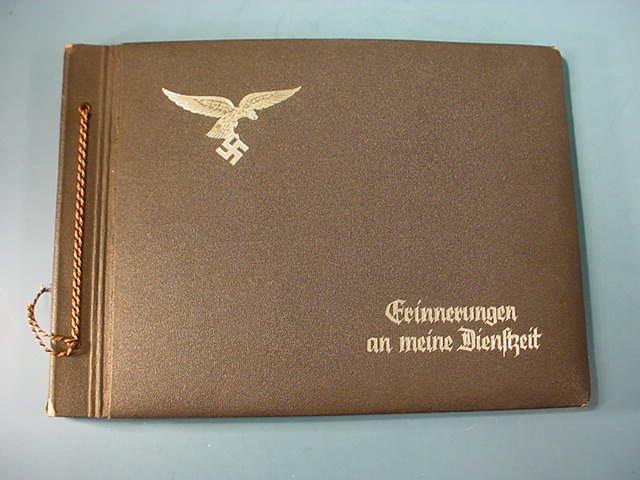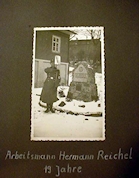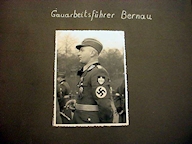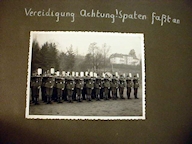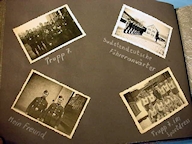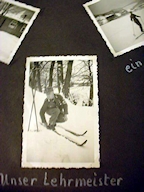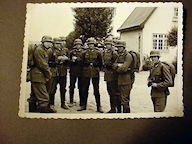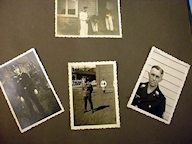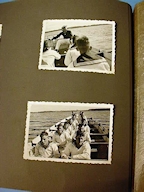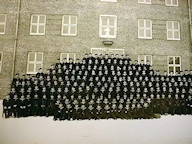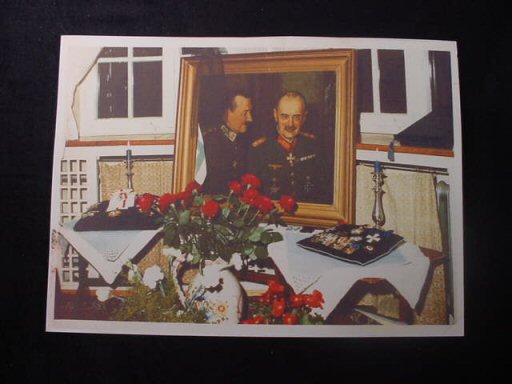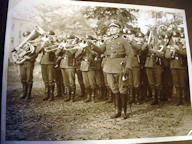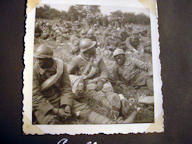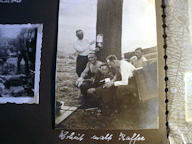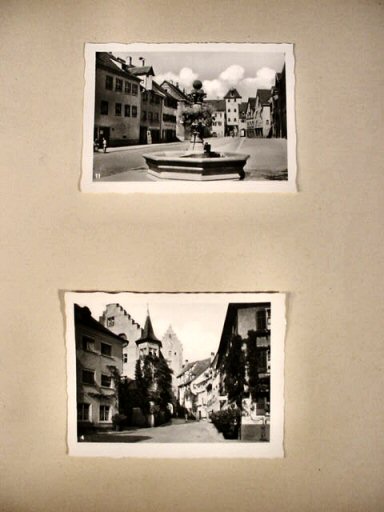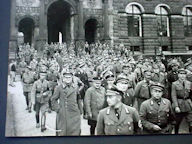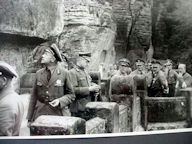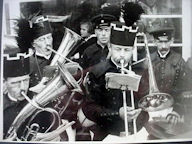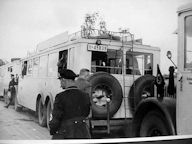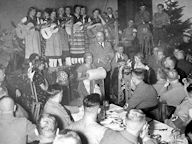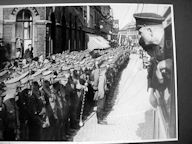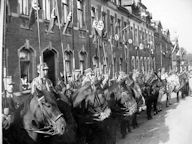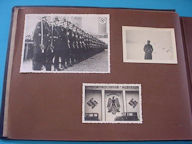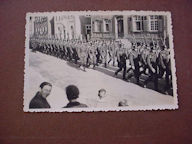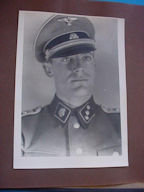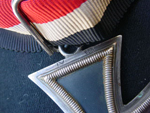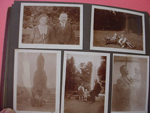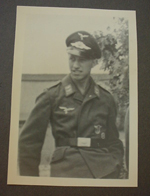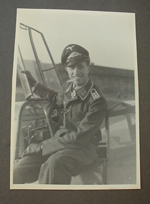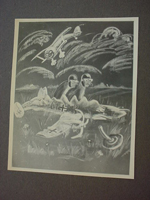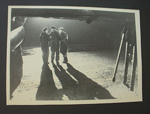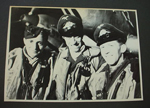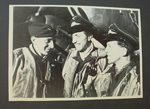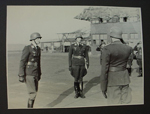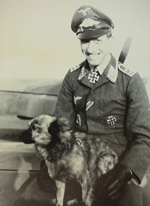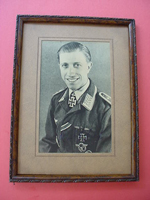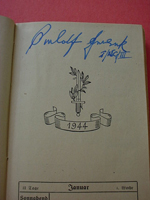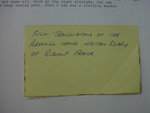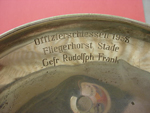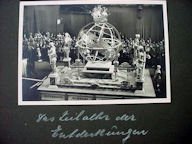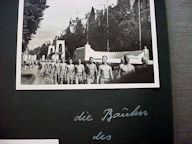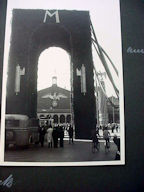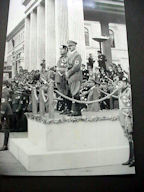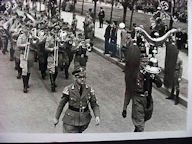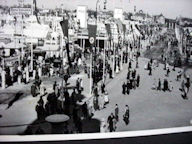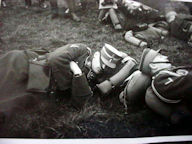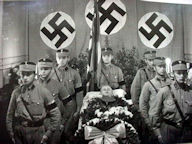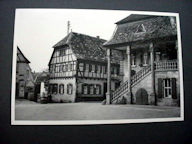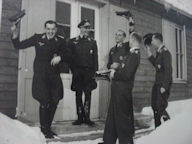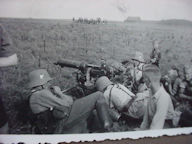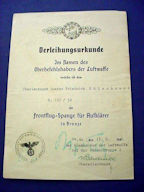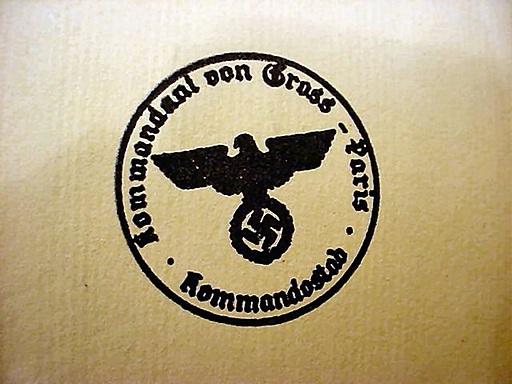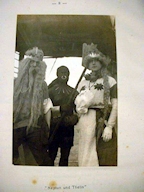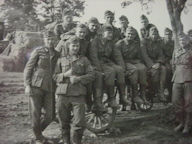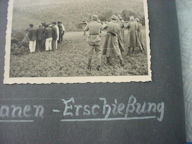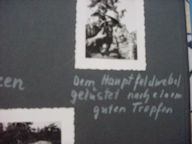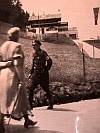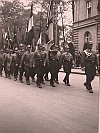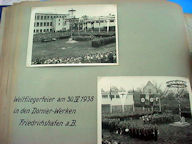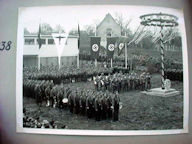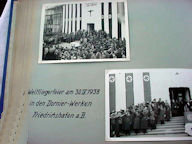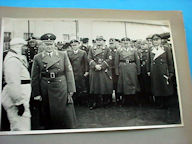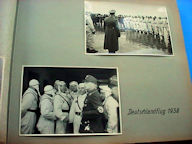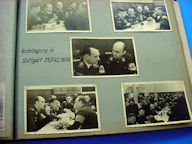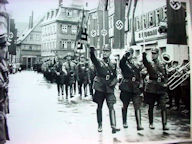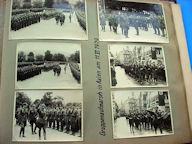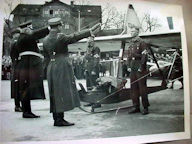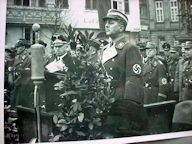|
|
|
|
Photo Albums
Page 4
|
|
|
Super German Album from RAD Days and Progressing to the Man’s Naval Service (Item ALBUMS 4-1) |
| DESCRIPTION: This album is a bit strange, but wonderful. First, the owner was in the Reich’s Labor Service (RAD) and then he graduated to the Kriegsmarine (navy), but the album cover that is in beautiful condition is for the Luftwaffe (air force). It bears the Luftwaffe eagle beautifully embossed in silver with the words Erinnerungen an meine Dienstzeit” also embossed in silver. Inside there is a handwritten dedication that may explain the Luftwaffe cover. Anyway, the inscription on the front cover reads (translated): “In memory of my service time.” The first dramatic-looking picture identifies the former owner who was 19 years old at the time when he was an Arbeitsmann (labor soldier), as Hermann. On the next two pages he shows pictures of his superior officers in 1939, and he is seen with his Zug (group) and his section leader, Kaufmann. On the next page 15 it is noted that the picture is missing. This is the only one missing of 134 taken when our Hermann was in the RAD and the other half when he entered the naval service in 1939 or 1940. I would have to say that 90 percent of the pictures show uniformed servicemen with images of camp life in lots of pictures of ceremonies involving his comrades, training-ship exercises, etc. This is definitely one of the better albums we have ever encountered. The personal touch expressed in these pictures is wonderful!
PRICE: $350.00 |
|
|
|
|
Great SA Marine Album (Item ALBUMS 4-2; SA 14-26) |
|
DESCRIPTION: Here is one of the 10 nicest albums we have ever had. It is in mint shape and is covered in a soft brown or tan linen cover. Unfortunately the tie strings are missing that hold it all together but quite easily replaced. It is anything but the normal German WWII-era album. It is chock full of beautiful and RARE photos. It would take more time than we have to describe all the pictures to you, but at least we will tell you about some of the most important ones. The album opens with a 5x7 picture of two very-high-ranking SA officials who are seen walking the height over the Hamburg harbor. The next page has a picture of Marine SA men in seated formation looking like they are awaiting assignment. On the next page is a small photo of an SA man who probably was the owner of the album and beside this is a group shot of about 15 SA Marine troopers. And below is a picture of a Schnellboote with 3 troops ready to board and then an actual picture of Rudolf Hess visiting with the captain and the first mate; then another shot of the Schnellboote with crew and then, lo and behold, a great picture of the whole assembled crew in size 6 ½ x 5. Then more pictures of the ship and crew and in subsequent pages more great pictures of the ship, officers, and crew. Also there are pictures of the training ships Horst Wessel and Gorch Fock. Then Surprise!, an original photo of Adolf Hitler with a shipbuilder launching a vessel. Then many more photos of the SA crewmen doing their nautical thing. Then more ship launching, a photo of the captain and then a beautiful 7x5 original picture of PRICE: $750.00; This is a very special album indeed! |
|
|||||||||||||||||||||||||||||||||||||
|
|||||||||||||||||||||||||||||||||||||
| DESCRIPTION: This is without a
doubt one of the finest assemblages ever offered from the personal effects
of one of the more important German generals. General Waldemar Erfurth was
the official Wehrmacht historian for the O.K.W., Supreme Command, and he
was a very close friend of Marshal Mannerheim of Finland. He virtually
lived in the Finnish Army Headquarters from June of 1941 until September
of 1944 as a German-language instructor in its War Academy. Years before,
in the 1920s, he had met the young Mannerheim and was his language
instructor at the same academy. His association with Finland and its
leaders goes way back to the WWI era. Erfurth and Mannerheim became fast
friends until the fatal end of the anti-Communist European struggle. There
is a color picture that goes with this grouping of General Erfurth's
funeral in the 1950s, that shows a portrait painting of the Marshal with
General Erfurth in earlier, happier days. The medal display pictured
alongside the funeral bier contained many Finnish orders, and a
photocopied page from General Erfurth's service record is also included
along with other information about him.
The collection includes: # 1: A large, fantastic album that is one of the most historically important pieces of documentation and photographic excellence to ever emerge from the annals of the Second World War. This huge leather-bound album is the official record of the historic meeting between Adolf Hitler and Field Marshal Carl Von Mannerheim of Finland. Mannerheim was the builder of the "Mannerheim Line," the western guard against Russia, and served as President from 1944 to 1946. The album contains 39 photographs in 9" x 6¾" format. They are mostly sepia tone and some stark black and white. Each one is a masterpiece of photographic art, leading us to believe they are Heinrich Hoffman originals. The Finnish shield is embossed in gold on the thick, leather cover. The overall size of the album is 17" x 12" x 1½" thick. This one-of-a-kind archival treasure was obviously presented to General Erfurth by the Finnish Government, or Marshal Mannerheim, himself. # 2: The complete dinner service having belonged to the late General consisting of 120 separate pieces of the finest in Dresden china. Dinner-Service List: 2 covered vegetable bowls, 1 coffee pot (no lid), 1 chocolate pot, 1 tea pot, 1 sugar bowl and creamer, 2 different-sized odd-shaped vegetable bowls (uncovered), 12 coffee or chocolate cups, 12 tea cups, 1 large meat platter, 2 large serving dishes, 2 different-sized oval dishes, 1 gravy bowl, 12 soup bowls, 24 tea cups, 12 dinner plates, 22 lunch plates, 2 dessert plates. The set is absolutely stunning. PRICE: Price on request. |
|
Great Picture Album of German Soldier’s WWII Memories (Item WEHR 34-14; ALBUM 4-3a) |
| DESCRIPTION: Here is one of the very best Wehrmacht Heer albums were have ever run across. First of all, the cover is in a rich, leather binding with a metal German Stahlhelm in the left corner (attached) and in silver print the words “Meine Dienstzeit” (My Service Time). The album definitely was the property of a soldier whose pictures occur all the way through the entire album. The opening largest picture shows the entire regiment including this soldier among them. Pictures include several bandsmen who can be recognized by their swallowtail epaulets on each shoulder. Thus our young hero was a musician and the next picture is of him with the bandsman’s swallows on the shoulders. He wears spectacles. In the next few photos he is seen in his new, recruit helmet and uniform with his comrades. Additional photographs show him at training in the 1930s followed with great pictures of the marching band and its bandmaster. Then comes a wonderful nighttime photo of the division’s playing at the Olympic Stadium in Berlin. This was a Grosse Koncert in 1937. Then there is a page with more pictures depicting the uniformed band. After that some more clear-and-concise photos of the bandsmen. After this the action begins as the regiment is sent on the mission to free the Sudetenland in 1938. Our hero is clearly seen in several of the photos and then they are in Austria after the Anschluss. Our soldier is seen again beating on a large, bass drum in the victory parade. Here are some great band photos. Then we see the opening of the French and Belgian campaigns. Note the dragon’s teeth that was meant to stop the German panzers (they didn’t!). There are some super pictures of the German soldiers in Prague and pictures of the early Panzers and all sorts of comradeship hijinks and beach parties. Then we see page after page of camp life, armored vehicles, R&R scenes for the warriors and then a couple of pages of pictures of French prisoners including Negroids and Arabs, smashed French tanks, field guns, airplanes, bridges, etc. There are more pages of the Germans relaxing and enjoying field chow. Many, many pictures vividly show us what it was all about, for real. This is about the nicest album that we have seen that is identifiable with one particular German soldier.
PRICE: SOLD |
|
||||||||||||||||||||
|
Great Wedding Album from Waffen-SS Officer (Item ALBUM 4-5; WAF 7-1) |
||||||||||||||||||||
| DESCRIPTION: Here is a prodigiously important album from the wedding of a Waffen-SS officer who, from his collar tabs, would appear to be an SS-Obertsturmführer, or first lieutenant. The SS marriage could be officiated by a priest or pastor if the couple were religiously inclined. There was no rule one way or another about this, but it could also be officiated by the commander of an SS unit who handed them bread and salt symbolizing life itself. There was an exchange of rings either standard types or the special SS rings with runic symbolism. See Item SS 21-3 for information on these special wedding rings worn by both the bride and the groom. There are 33 pictures that are all original; not copies. They were taken with at least two types of film one of which was developed with the ragged edges, and the other the straight edges. We presume that this wedding took place in the war years because of the impressive group of medals that the groom wears. He also wears the adjutant’s cord so was probably an aide-de-camp to all well-known field commander. The first two pictures show scenes of the German village that was where the ceremony took place; a very typical setting probably in the Rhineland from the style of the buildings. Then we see the arrival of the bride and groom and the wedding party (other officers). On third page there is highly interesting picture of the bride symbolically touching the bread which contains the salt while the groom holds an SS sword by its blade as a symbol of honor and protection of his home and family. Next there is a picture of the man who performed the ceremony whom it seems is an NSDAP SA leader, probably the civic officer who performed such marriages on a regular basis. Next is a wonderful picture of the young couple exchanging wedding rings and then a picture of an SS officer (best man?) giving a talk about the young lieutenant, his comrade. In the next the groom reaches for a pen and then signs the wedding roster and then the bride signs as well with an SS officer witnessing this. There are a few repeat pictures here in different sizes. Then comes the sacred moment when they are joined together. Some of these pictures are also duplicates in different sizes. There is a beautiful picture of the couple they leave the building together. There is also a nice picture of the mother of either the bride or groom and some relatives sitting at a table. The best man and lady are also seen leaving the premises after the ceremony. Other pictures are shown of family with the marrying official (poorly taken with flash defect). There is a great picture of the couple in the auto once again with the NSKK official conversing with the ranking officer. There is a neat picture of the NSKK official who was also present. There are two really great pictures of the whole wedding party, officers, ladies, and the marriage official. The album is put together with plywood covers. The pictures range in size from 3 1/2 x 2 1/2 inches to 5 1/4 x 3 1/2 inches. The album is a historical archival treasure so seldom ever seen covering this aspect of the saga of the SS. The album measures 11 x 10 inches and is a wonderful, original, precious item to be preserved in honor.
PRICE: SOLD |
|
||||||||||||||||||||||||||||||||||||||||||
|
Rare Original Photo Album Featuring Rudolf Hess (Item ALBUM 4-6; HESS 1-1) |
||||||||||||||||||||||||||||||||||||||||||
| DESCRIPTION: Here is a fantastic photo album of original pictures of NSDAP ceremonies, ritual events, and most important of all, here are great photos of the Führer’s Deputy, Rudolf Hess. There are about 60 photographs; all top-quality, clear images. The first 20 or so are of the visit of this great man, “Der Stellvertreter des Führers” (“The Deputy to the Führer”), to the famous Bastei, the wonderful rock formation that towers high over the Elbe River near Dresden. The rocks reach 1000 feet above sea level. The Bastei has been a tourist attraction for more than 200 years and it was only natural that this important celebrity, later referred to as “The Prisoner of Peace,” would be interested in visiting this German national treasure. There are several great images of his arrival, the grand reception at the opera house in Dresden, and the gathering of the NSDAP Party officials who would join in the climb to the top. The buses to take the deputy and all the N.S. members to the summit are shown with several great candid photos of the handsome and truly photogenic Hess. Robert Ley, the labor leader, is shown with Hess in several pictures. The tallest rock is shown with the observers seen at the top and finally the group is seen leaving this fantastic site and disembarking by bus. Beyond this there are some really nice photos of Dr. Ley’s visiting the town of Glashütte (the clock city) for a meeting of the Alte Kämpfer (old fighters of the party). There was a great ceremony attached to this with SA and mineworker’s bands. One most interesting picture is of athletic Hitler Youth boys forming a huge “A” with their bodies. There are many pictures of the official N.S. buses bringing Party members to meetings, ceremonies, etc. There are many more early shots of celebrations with lots of swastikas. Many dignitaries are photographed, as well as beautiful children from the city of Dresden. (Did any of them survive the vicious Allied bombing?) There is a great shot of an SA rider group on horseback. The pictures are of a good size, 7 x 5 inches. The album is in well-used condition, but holding up well! Inside the front cover, you will see a couple of sheets of a cotton material placed to give the album some stability. The album measures 12 x 17 inches (big). This is one of the most historically important albums we have offered or even heard of. Anything pertaining to Rudolf Hess is considered rare, really rare! Consider it as a sort of a silent memoriam to this brave individual who was willing to give his all to bring about peace in our time. Price $2,995.00 This is practically a giveaway that we extend in the hopes that it will be purchased and be given a place of honor is some museum or important historical archive. A Historical Perspective: As war between Germany and Britain intensified, Rudolf Hess despaired at the total lack of peace negotiations. Hitler had several times proposed an honorable end to the war and ardently desired a negotiated peace, but German diplomats were rebuffed repeatedly. Hitler offered to resign if that would assist the commencement of peace negotiations, but their efforts met with no response. Visions of long rows of coffins of women and children haunted Rudolf Hess, and getting peace negotiations moving became his top priority. It was discovered that British Prime Minister, Winston Churchill, had forbidden his diplomatic corps to entertain or forward any German peace proposals, even via neutral countries. The British Duke of Hamilton was identified as a man sympathetic to the British "Peace Movement,” who had personal contact with King George. Many British subjects openly opposed to the war had been imprisoned by Churchill, including a British member of parliament. Rudolf wanted to bypass Churchill and take Hitler's peace proposals directly to the king, via the Duke. It proved too difficult to set up a meeting in a neutral country and therefore Rudolf decided to go to Scotland and do the job himself. He thought the highest price he could pay was his own death. This assumption was mistaken. The price he would pay was much, much higher. He spent more than 40 years in solitary confinement in Spandau Prison, while the man most responsible for this greatest injustice sat on his fat buttocks, dead drunk with the proverbial cigar shoved into his grotesque, lying mouth. This was the arch criminal Churchill, whose only close competitor in murder was Stalin, but the record shows that just before British agents murdered Hess, the Soviet leadership was definitely in favor of releasing him. For a detailed explanation and clarification insert “MARTYR RUDOLF HESS” into your favorite search engine to see the whole verity as told by Rudolf’s son and presented by National Vanguard. Rudolf Hess was born in Alexandria, Egypt, on 26 April 1894, and foully murdered at the age of 93 on 17 August 1987, by either American or British “Special Mission” thugs (Special Branch or CIA?). Because of his historic flight to Britain on 10 May 1941, the odyssey of R. Hess was known to those who would bravely ignore the New World Order distortions as “The Prisoner of Peace.” Today, it is well known that Adolf Hitler never intended to conquer England and it becomes patently obvious that he furthermore knew and sanctioned the mission that Hess set out to accomplish for peace in the western world. It was a desperate gamble; the truism that emerges is that Hitler desperately wanted to maintain good relations with Britain and the English people. The declaration of war after the German invasion of Poland had surprised and even deeply dismayed him. As Hess would later explain in England, “The Führer had never wanted war with England. He had a high regard for the English people, for their culture, for the British Empire, and for the civilization they had spread throughout the world.” We know today that the Führer had quite purposely silenced and held back the Panzers and the Luftwaffe that were extremely mighty in 1940. He did this so that the British expeditionary force could escape from Dunkirk. This should be patently obvious to any rational thinker of Germany’s peaceful intentions toward Britain and it also interconnects with the peace mission of the Führer's personal Stellvertreter (Deputy) and close friend. After 47 years of inhumane imprisonment, the powers that be made sure that he would never be released from the cruel prison; they stood in fear of what he would say to the world, possibly exposing the true meaning and agenda of Germany and Adolf Hitler with the West. At that point, the conspiracy and its perpetrators would be exposed for the entire world to see and hear. Hess had to be silenced! The details of his so-called suicide are ridiculously propounded by the Allies. The Prisoner of Peace was martyred by the “New World Order.” It had always been the Soviets that vetoed the humanitarian release of the old man, and it was true that the Reds wanted him to die in prison. To them he was a symbol of political importance. Hess had committed the “greatest crime imaginable”—he sought to unite the western powers with Germany. Had this been successful, the “Evil Empire”—as President Reagan later described Soviet Communism—would have been smashed! During this period, though, the “Evil Empire” began to take a new political course. Signs indicated that the Soviet Union, under the administration of Secretary General Mikhail Gorbachev, expected to discharge Rudolf Hess. This release would be consistent with Gorbachev’s policy of reconciliation and glasnost ("openness") and would be accepted around the world as a major step of good will. The Soviet Union leaders finally decided that they would no longer stand in the way of Hess’s release. This immediately sent shockwaves among the American conspirators and their British counterparts. Now the whole canard of their blaming the Russians for their inhumane outlook in the affair would no longer wash. So, the murder plan was set into motion and carried out. Of course, today, all of this is closely managed history—Orwellian in nature, but true historians know the obvious truth. The album contains about 65 pictures all clear and crisp featuring the visit of the Führer's deputy, who was practically the only man who could use the familiar form of “you” by saying “Du” when addressing Adolf Hitler—he was that close to his Führer and always a devoted follower. The pictures in the album are in size 7 x 4½ inches. The first 18 are all various photos of the visit Rudolf Hess made to the German town of Glashütte. There are tall, natural, rock formations near this town. In one of the pictures, a sign is posted over an entrance gate that says: “Die alte Uhrenstadt Glashütte grüst die alten Kämpfer” (The old watch-making town of Glashütte greets the “Old Fighters.”) We believe Glashütte had been chosen for an annual meeting of the “Alte Garde,” the League of Men of the Freikorps, SA, and political leaders who supported and built the N.S. Party from its beginning in Munich and other parts of the Reich. The opening of what was most likely a 3- or 4-day event was honored by the visit of Rudolf Hess, Dr. Robert Ley, and other N.S. notables. The entire town is gaily festooned with thousands of N.S. flags and swastika bunting, and Gauleiter came out for the event. SA men, including the SA Reiterkorps (Horsemen), and towns people in traditional district costumes intermingle with various musical groups. A special opera performance is staged for the honored guests. The town’s monuments are surrounded by uniformed figures in resplendent gear. Buses are shown that brought the N.S. celebrants to little Glashütte. This town is in Sächsische Schweiz-Osterzgebirge (Free State of Saxony, Germany) which was the birthplace of the German watchmaking industry. The town is southeast of Dresden. Besides all the castles, mansions, and museums, one of the must-see places is the bizarre rock formations at the Saxon Switzerland National Park. This park was visited by the Alte Guard shown peering over the landscape. How “WUNDERBAR!” to scale some of the climbing peaks that tower more than 600 feet above the Elbe River. The amazing rock formation is known as the mighty Bastei. It is still a major tourist attraction for millions each year. This Saxon town of Glashütte was originally settled by the Teutonic peoples in antiquity and some of the many nearby fortresses were later built to protect trade routes, but some were also used as nests for later medieval raiders and Landknechts. The park was considered not only historically important, but sacred in the Third Reich mythos. It is quite natural that the official N.S. visit is chronicled in the album. In at least two of the pictures, Rudolf Hess is looking from on top of one of the rocks at the other rock formations. The album is replete with pictures of the Saxon German people in an era of national feeling and thankfulness. This was Germany united in the common purpose and goal of National Einigkeit (Unity). But, poof, like the American Confederacy, it’s “gone with the wind”! The album measures 12 x 17 inches and is a little over an inch thick. It’s in generally good condition with hard covers. This is an absolutely historically important archival treasure and should be preserved in remembrance of the man who suffered greatly in the cause of peace (RIP Rudolf Hess)—you were a much better man; a greater, gentler humanitarian than any of your enemies (WELTFEINDE). |
|
||||||||||||||||
|
||||||||||||||||
| DESCRIPTION: Help! Okay, we admit that sometimes even we need help on identification of some of these items. We are rather stumped on this one. We show here a few pictures of men in uniform hoping that some of you out there might recognize the pictures and tell us what we have here. In back of the album are some great pictures of young men of the NS Agrarian Association (Farmer’s Group) with their distinctive flag. Is it possible that the uniformed men are also of this group (Reichsnärstand)? The album comprises 65 pictures in a petite size of 7.5 x 5 inches. Just about all the pictures are personnel and uniform. These must be rare, as we have not seen these uniforms before.
PRICE: $165.00 |
|
||||||||||||||||||||||||||||||||||||||||||||||||||||||||||||||||||||||||||||||
|
||||||||||||||||||||||||||||||||||||||||||||||||||||||||||||||||||||||||||||||
| DESCRIPTION: Collectors, archivists, museum personnel, here is a great SS album. According to the layout of the pictures it would seem that the album was put together by Herr Hugo Albert Denkhaus, 20/10/1919-2/3/1986. Denkhaus was an SS-Untersturmführer; at least at the time that the picture that appears on his death notice was taken. The large black-leather-covered album measures 11 1/2 x 15 inches and is filled with about 290 photos and a postcard or two. There are pictures of the young recruit Denkhaus and many of the pictures trace his history in the SS, but he also includes pictures of relatives, civilians, NSDAP, veterans’ organizations, and many school comrades, former work friends, etc., who were now in the Waffen-SS, navy, army, etc. There are pictures of SS men engaging in various sports, weapon maintenance, guard duty, clowning around, marching exercises, and at R & R. A great one has a team riding a rocket into space! There is a page where groups of SS soldiers are putting on reenactments of bygone Germanic times; scenes from the era of Frederick the Great, and the Franco-Prussian war are featured with vividly authentic costume. Gradually we move into appropriate photos up to the war, but before this there are pictures that he personally took at the 1936 Olympic Games that include at least four close-up pictures of Adolf Hitler. It is so rare to see snapshots of the führer. Usually only Heinrich Hoffmann or his staff was allowed to point a camera at Hitler. Four of the Olympic snapshots include Marshal Hermann Göring; also quite rare to be taken at a close angle by an SS man. Von Tschammer, the Reichssportdirektor, is also seen in these shots. There are two pages of pictures that appear to be competition between party functionaries such as the SS and SA; possibly at the Winter Olympics at Innsbruck. Another page chronicles the entry of the Wehrmacht into Vienna and here are two more candid pictures of the German führer and Göring in a remembrance ceremony and Göring in review of Wehrmacht troops as he salutes them from his Mercedes auto. There is also a very candid shot of Göring dressed in his bearskin cap (this is a really great one!) and two more of Göring who comes to his train compartment to wave and give the “Heil Hitler” salute to some admirers. There are great pictures of various guard posts and barracks of the SS. There are some really great pictures of typical soldiers in clown acts; Landsers with wives and sweethearts, horses, trucks, and ships. There is a picture of English war-dead coffins being reverently decorated by German soldiers; a visit to the Hindenburg Tannenberg monument; then into the scenes of war devastation and fiery action probably in Poland or France, bunkers, pillboxes, crashed planes, Christmas at the front, and perhaps out-of place-scene of the Nuremberg Parteitag (party rallies). The second to last pages are set aside for some miscellaneous pictures to include shots of more Christmas celebrations, various frontline R & R shots, and a page with six nice photos of what is probably a relative in the Kriegsmarine, two pictures of German army personnel, and a great postcard-type photo of a group of WWI soldiers from 1916. Possibly SS man Denkhaus’ father could be one of these Landsers. Then there is a page of pictures of the young lad of the Kriegsmarine with his proud mother and an army noncom and two Luftwaffe airmen. The last pages are dedicated to SS-Untersturnführer Hugo Denkhaus. There are two color pictures of his grave and about four of the remembrance cards with black mourning edges. The former SS comrades are shown at a memorial service honoring him and a larger remembrance picture of this brave soldier is presented with the words: “Wir trauern um unseren Kameraden: Hugo Denkhaus seine Ehre heiss treue.” This translates to: “We gather around our comrade Hugo Denkhaus. Your honor was called loyalty. This has to be one of the finest collections ever to be amassed in historically important archival pictures concerning the Waffen-SS in general, and we fervently hope it will fall into the hands and collection of someone who will treat it with the respect and honor that it deserves. How it ever came to be sold or discarded is a mystery to us, but it truly needs preservation.
PRICE: $2,500.00 |
|
|||||||||||||||||||||
|
|||||||||||||||||||||
| DESCRIPTION: We purchased this one at a flea market and were quite surprised to have found it there as it is in fine condition. It is a standard photo album size 12 x 9 inches. The covering looks to be leather or leatherette. It has the embossed SS rune symbol in silver color on the cover along with a metal SS cap skull (Totenkopf). This appears to have been there for ages! And I am positive it has been. Also, you can see the silver embossed words “Meine Dienstzeit” and this translates to “My Service Time.” The pages include some 20 5 x 7 photos and 25 others that are mostly 5½ x 3½ inches. The larger pictures may have been ones that the original owner photographed from the album of a comrade, as they are not as sharp as the 5½ x 3½-sized ones. All of these are original, first-view photographs. The album owner also included on the first page a fine photo postcard of his boss Obergruppenführer Sep Dietrich. That along with a magnificent original photo of Allgemeine-SS troopers with the SS-Leibstandarte Adolf Hitler Standarte. Here is a treasure of history, rare and truly historically important.
PRICE: SOLD |
| ||||||||||||||||||||||||
|
German Photo Album from a Luftwaffe Doctor in France (Item ALBUM 4-10; LUFT 14-15) |
||||||||||||||||||||||||
| DESCRIPTION: This is a great and quite rare album from the Luftwaffe lazerett in Amiens, France. It was put together by one of the doctors stationed there. “Lazerett” is translated as “hospital” or “sickbay.” There are 107 pictures and as usual with all German military albums they are different sized ranging from 7 x 5s, 3 1/2 x 2 1/2s, 6 1/4 x 4s, etc. The pictures are all black and white and crystal clear. The first of them depict the hospital and the medial staff. Then we have various training pictures including preparations by the security staff such as firearms training; very important since the cowardly scum of the French marquois favored attacking German hospitals in their terror rampages. Sports were very important and some of the pictures feature this aspect. Table displays of therapeutic products and items made by patients are shown. The French personnel (pretty ladies) are seen. Various sections of the hospital compound are shown. Various medical buildings in the area that were destroyed by bombing or partisan activity are also shown. Scenes of class lectures are shown with swastika war flags evident. Entertaining for the wounded airmen was important and is displayed in the pages. The album measures 11 1/2 x 8 /12 niches and is in wonderful shape.
PRICE: $685.00 |
 Rudolf Frank |
 Funeral Pillow |
 |
Night Fighter Grouping of Ace Rudolf Frank (ALBUM 4-11; LUFT 19-1) |
DESCRIPTION: This is, without a doubt, the most important article ever offered on Germania’s site; certainly the most moving! These articles, albums, medals, and documents were either the property of, or the story of, this, one of Germany’s heroes of the sky. The story is unique and vastly important. Yes, victory goblets (Pokale) and Luftwaffe generals’ swords, Reichsmarschal Göring items such as batons, etc., are exciting to have and to hold, but here is a sad, but noble, story summed up with the actual items in evidence. This story needs to be recounted some day in book form. The three photo albums with the group are stunning including the one from Frank’s Luftwaffe Night Fighter Squadron with his artwork and squadron badge attached on the cover. The second album is his own Luftwaffe album including added photos of a longtime crew member, who was also a K.C. winner later on. The third album is a small, private family album given by Frank’s commander to the family. The term “Terrorflieger” (Terror Fliers) is what the Germans called the allied bombers that were raining destruction and murder over the Fatherland. The night fighters’ mission was to shoot down allied planes, and they did so by the score. Many of them were American, British, and Canadian. The instrument of this successful shooting gallery, was the Messerschmitt-110. Yes, the allied mission succeeded, but at the cost of hundreds, perhaps of thousands, of allied aircraft and usually their crews of seven men. They had come to do murder and fell victim to the young eagles of the Luftwaffe. The Germans had advanced radar systems to warn them when the bomber streams were approaching. They went after Americans usually during the day and the Canadians and RAF during the nighttime. The lumbering bombers were easy prey in daylight, but the Luftwaffe had a harder time finding the murder machines at night until they developed a new secret weapon -- a tracking radar antenna fixed to the nose of their fighters to close in for the kill at night completely undetected by the bombers. Then they would use another secret weapon -- and upward-firing gun called Schräge Musik, “Slanting (jazz) Music.” Many bombers fell victim to this marvelous weapon. The main problem for the fighter pilot was to avoid being hit by pieces of the exploding bomber. The Luftwaffe night fighters and their supporting organization put up an astonishing performance in dishing out just retribution for the murderous campaign of the likes of bomber Harris (May he be walking the “hot coals” as we speak). These young men continued to fight and cause the allies serious losses until their last airfield was overrun, and then ended the war morally undefeated (those who survived). They had the advantage of knowing what they were fighting for (Europe’s survival). They fought valiantly for their nation and the preservation of what was left of their homes and families, cities, and people. Rudolf Frank was one of the best of these air warriors with 45 victories -- all in Night Fighter missions. He was very popular on the home front and today, a signed photo of him was recently sold for $800.00. He flew only in the Battle of Britain. He is listed in ‘Horrido’ in Ader’s History of the German Night Fighter Force, 1917-1945. On the internet, you will find Lt. Frank mentioned in several instances to include one called Air War over Denmark, where he is credited in bringing down an outbound Stirling III EF137. That Frank was a hero is unquestioned and a much adored comrade by his crew and all Luftwaffe personnel that he came in contact with. He was a dashing, witty, and responsible officer with patriotic fervor; a truly honorable son of the German soil, who took to the sky. In his radio operator’s logbook that is included in the group is this entry: “Frank managed to line up the aircraft and did the famous sewing-machine stitch along its belly…following closely in case more ammo would be needed and looking for telltale signs of a hit before trailing off to the left or right…instead, the Wellington bomber arched downwards hitting Frank’s Me-110, he ordered his radio operator and air gunner to parachute while he struggled with the controls.” Both survived this tragic episode and the war. There is a photo of them with the group standing at Frank’s gravesite in the 1970s. In the end, Frank was unable to save the plane or himself. He torpedoed earthward and did a twister into the ground in Holland. Later, the wreckage was salvaged by the Luftwaffe and sadly, Frank’s mutilated and mangled body was discovered hanging within the plane’s structure. He was intertwined in straps and cords. He always wore his Knight’s Cross on the missions. The ribbon was soaked in blood and the KC was damaged, as well. So, at his funeral for the traditional pillow display, his comrades raided the stores and got a longish length of Iron Cross 2nd class ribbon that is narrower than the RK type and they attached it to the damaged Knight’s Cross and mounted it on the funeral cushion. This you can clearly see on the close-ups of the cushion. Lt. Frank’s young bride was pregnant with their child, a little girl. Hence, the latter official Führer letter awarding large funds for the widow and the child as dependents of a German hero, etc. Frank was then recommended for a posthumous award of the Oak Leaves and promoted to lieutenant. This was confirmed by the Führer. A copy of the letter from the commanding general of the 1 Jagdkorps to his widow is also here. It's dated 7/8/44 and says: “Dear Madam, on 20/71944, your husband and father Lt. Rudolf Frank 3/NJ-3 as 531st soldier of the German Wehrmacht so honored, when he was awarded the Oak Leaves to the Knight’s Cross of the Iron Cross. Thereby, the bravery which this exemplary soldier displayed right up to his hero’s death was given the recognition of this well-earned honor by our Führer. Your husband will never be forgotten in our fighter corps, both as officer and comrade. We hope that the knowledge that [this] brave life as a soldier will attribute to the forthcoming victory of our Fatherland and will bring you some comfort in your grief. In faithful memory Heil Hitler!” This was signed by Bepo Schmid, Commander. This grouping consists of the following items: # 2 The collector who ended up with the entire group felt that in respect to Rudolfs Memory the pillow should have a Knights Cross displayed on it So we know that post war knights crosses were struck in Germany for replacements for Recipients of the K.C. who lost their original issued medal when they were captured or were deprived of the almost sacred relic through other consequences of the times. The Knights Cross was able to be worn at reunions but without swastika and the few companies that made them would make sure that had an oak leaf branch instead of the “Hackenkreuz”. But if the Ritterkreuztrager wanted to have one with that symbol that he still thought of with reverence then it was possible to have one made to exact specifications and this was evidently done in this case We do not know which of the previous owners ordered it but it is far beyond our comprehension to recognize any difference between this cross and an original but there was a note with it when it arrived to the effect that the KC was in fact a replacement and this was put on the funeral pillow because it simply had to be there ! So it is to be sold to the next collector with the understanding that it is not a $7.000 Knights cross rather it is an exact and beautiful museum grade replica. As for the other medals on the pillow they are all 100% Franks original awards 3.) Iron Cross 2nd Class, 4.) Deutsches Kreuz in gold), (German cross unmarked 5.) Pilot Qualification badge marked CE Junker, Berlin. There is a space at the top for his Night Fighter close-combat bar, but it is not there. Some of his medals were sold or given away by his wife earlier. 6.) Album #1 - This, to me, is very sad.- - His childhood pictures as a baby and as a young boy with his baby brother, his mom and dad, who was it seems a shoemaker, just like my father was . His grandparents are there as well. 7.) Album #2 - This album is named Kriegserinneurngen (War Memories). This is an album presented to Frank by comrades of the Night Fighter squadron. Friends are included and with the first picture signed by a Knight's Cross winner. Many pictures of Lt. Frank are there in uniform for dress and aerial combat. A touching picture is of Frank's pet dog shown at the ready for defense of the Fatherland, he is sitting at the boots of squadron members. 8.) Album #3 - This is the album presented to the widow by the squadron. On the cover are the squadron insignia and a painted Knight's Cross, all hand-done and it says: "To the wife of the Knight's Cross Winner." It includes his rank and name. It has great pictures of the squadron room command center with all the flying officer comrades and Frank's ever-present little dog, who was always by his side. Some of the night flight preparations are great and nothing like them has been published (at least in that era) that we are aware of. -- Great dark-of-night photography. There are his officers, his crew, pictures of this stalwart youth beaming with his well earned KC. One of the pictures shows him with all the medals that are in the group being worn. Then, as tragedy struck, the rest of the pictures are of the hero's funeral with the picture of a Luftwarre comrade holding the actual funeral pillow that is in the group. His casket is borne to the grave covered with the Reichskriegsflagge (war flag) as its cover. The widow, dressed completely in black, walks with her father-in-law and the commanding officer of the Staffel. A Luftwaffe band plays the "Ich Hatt Einen Kamerad," (I Once Had a Comrade). Lt. Frank is laid to rest in correct Germanic ceremony. "The ones that God loves best are taken earliest to his bosom." The ribbon on the wreath says: "Meine Lieben Mann," (My Beloved Husband). There is a framed, signed picture in a beautiful, wooden frame of KC winner Rudolf Frank (hand signed). It measures in the frame 12" x 9". The picture by itself is 5" x 8". There are two photos of paintings that were, thank God, kept by the window. One is of Frank and one is of H.G. Schierholz, his radio operator. Frank's diary in the form of a Deutscher Luftwaffen Kalender, 1944, is also here. This is his record of his best multiple victories. In some of the pages he has hand-marked "Abschuss (3), (firing) Abschuss (2), etc. The diary is especially interesting in the back where it lists Knight's Cross winners. There are silhouettes of enemy aircraft -- Spitfires, Warhawks, Whirlwinds, Liberators, Flying Fortresses, Wellingtons, etc. There are tables and illustrations of weapons, tactics, pictures of artillery, and various Luftwaffe aircraft, etc., and in the back are interesting ads for Luftwaffe-related articles. There is another small album given by the squadron to the widow which contains more 3 1/2" x 5 1/2" photos of the funeral; there are about 20 of them. There is a picture of the newly married couple, too, in pre-KC photograph. A group of photocopied papers are part of the group. They are copies of his radio operator's Flugbuch (flight book). His radio operator Oberfeldwebel Hans Georg Schierholz is mentioned frequently.With this grouping is also the record of the victories (kills) by Frank while with the aforementioned radio operator. The location of each kill is recorded here, as well. The copy of the certificate for the award to Frank of the Ehrenpokal (Honor Goblet) is included as well. This was for exemplary service as a night fighter. The award for the Deutsche Kreuz in gold is there in copy, as well. There are several pages of reports from 1943 by various Luftwaffe officers (translated into English) chronicling various victories by Lt. Frank. These are vastly interesting reports. They mostly have to do with the final sanction and credit for the victory of a “shoot down” of a Shorts Brothers Stirling one year later. Included also is a four-sheet record copied from Frank's original victory list of all of his 45 victories with aircraft type and the places where he shot them down. There are 32 pages of translation of the hand-written diary of Rudolf Frank. Its prodigiously interesting and often humorous. On 11/1/44, he participated in a combat where 136 American planes were shot down. This particular item, because it is not the original material, might not be worth as much, but to me it is the greatest part. This is the personal feeling of this hero, who died for people, Führer, and Fatherland. Found here is a copy of a certificate signed by Frank where he is put in charge of the Ju-88 and is facsimile-signed by the commander of the Geschwader. Frank testifies: "I am going to steer this airplane for the protection of my homeland and to final victory." 17/4/1944. Luftwaffen Flugzeugfuhrerschein - This is Rudolf Frank's actual Wehrpass (ID booklet) and is part of the grouping. He received this on November 1, 1943, when he was assigned to Frankfurt on the Oder. At that time, he was an Oberfeldwebel. Another section of the group is encased in a plastic holder and is comprised of newspaper reports photo copied from originals about Frank and his victories and the earliest victories of the night fighter arm. There is a page (translated) that lists new Oak Leaf winners at the Führer's headquarters on July 27, 1944. It has a nice notation about the shoemaker's son, who unfortunatly did not live to receive his decoration. There are two translated stories by war correspondent Karl Heinz Eckert about Oberfeldwebel Rudolf Frank, who achieved five victories in a single night -- utterly fantastic reading. There is a copy of articles from a German Luftwaffe magazine called Fur Tapferkeit - Das Ritterkreuz with pictures of top-class winners, 17 of them to include Frank. There is a picture of a drawing of the lieutenant and a lovely letter to his family on 3/7/42, where he related to them how on the night of 29 June - 30 June, 1942, he completed his sixtieth sortie. At the end of this narrative he demonstrates the chivalry of the German airmen when he approaches two "Tommies" whom he has just shot down in air combat and he recounts that he shook their hands and had a nice, comradely conversation. There are copies of the death card of Rudolf Frank. There is a copy of a letter from the Chief Adjutant of the Wehrmacht to the Führer. This is a copy of the announcement to Liesa Frank, the widow, to tell her of the award of the Oak Leaves to her deceased hero husband and to inform her that a savings account of 5,000 RM for their daughter's education was granted by order of the Führer, who has willed it because of the husband's death on the glorious field of battle; this is by order of the Führer and the General of the Infantry. A similar letter from the commander of the L.29 No. 759 Night Fighter Squadron dated 4/8/44, tells her that she has every right to be proud of her hero husband and it was the care and love that she provided, which gave him the strength to accomplish acts of heroism. There is a copy of a Deutsche Reichpost telegram 7/5/44 that says: "In connection with the deep sense of loss which must have been felt by you through the hero's death of your husband, I should like to express my sincere and heartfelt sympathy." Signed in hand by Adolf Hitler. Yet another set of copies are included of magazine pictures about Frank and copies of the certificates for the award of the Knight's Cross and the Oak Leaves. Included is a picture of Frank and a write-up about his 183 missions and his amazing five victories on 20/2/44. He is called one of the most successful Night Fighters. It tells of Frank's being killed when his Me-110 was rammed by the shot-down Wellington bomber. Oak Leaves and promotion to Lieutenant Frank posthumously followed. There is a silver bowl that was awarded to Frank when he was a mere Gefreiter in 1938 at the Fliegerhorststade. This was for an officers shooting event or Schiessen. The bowl with a 7" diameter appears to be silver, but could be plated. It has fine engraving and ball feet. Frank evidently preserved one of the shoulder boards from his early days when he was a Gefreiter. It is plain gray, cotton material with yellow piping for flight personnel. His Obergefreiter patch embroidered in silver bullion is included. It has three birds flying information in a silver circle. You can see this on some of his photos. So, here are the remaining effects of this valiant airman who fought and died for Germany. It is a very impressive lot, indeed, I believe that there is a deep, spiritual meaning to this grouping that entirely transcends the mere collecting hobby. The meaning, sacrifice, loyalty, and sadness all combine in these relics and the memories that they invoke. Frau Frank later married, of all persons, an RAF officer, and left for England, hiding all the photo albums and funeral cushion in the attic, She had no contact with Frank's mother and family or with her daughter in Australia and we know the family had other awards, etc.
The collection actually changed hands a couple of times thereafter. It can be hoped that Liesa sold the other items so that they would at least fall into the hands of a legitimate museum or a collector like you. We do know that several items showed up including Lt. Franks Luft- Pokal at the Hermann auction house in Munich not long ago. This is a very special grouping -- Very special.! Nothing we have ever offered is more meaningful or important. PRICE: POR |
|
|
Utterly Fantastic and Original Important Photograph Album (Item ALBUM 4-12; NSD 22-5; ART 18-10; SPECIAL ITEMS) |
|
DESCRIPTION: Here is the most important photo album we have ever seen, and certainly the finest. The pictures are brilliant and to a point of absolute photographic perfection! There are 195 photos that seem to say it all about the Third Reich’s “Imperium”! It starts with pictures of the Haus der Deutschen Kunst from the time when this beautiful building contained gorgeous artistic renderings that staggered the viewer with charm and strength, patriotism, and decent emotion aforethought, unlike what utter degenerate trash that has been thrust into those hallowed halls today after they removed the word Deutschen. There are about 16 pages that fantastically chronicle the finest and greatest parade that anyone can envision since the triumphal Roman legions in their celebrations of victory. The beautiful trappings for the celebration and procession are shown making the old city bright and radiant by night and day and then the march known as “2,000 Years of German Culture” follows. The parade begins with full battle-ready Viking ships and Norse warriors. Father Rhine is depicted in a boat surrounded by Rhine maidens, knights on horseback, celestial floats, Wagnerian themes, knights and emperors, Goths and Deities, and eagles galore! The massive and stately Richard Klein eagle and swastika are seen on a float. There is a model of the Reichstagsgebäude in Berlin, runners carrying torches from the 1936 Olympics, a regiment of Grenadiers from the time of Frederick the Great, and a final picture of Wehrmacht (Army) (Heer) presenting its colors to a military assembly. Also, there’s a march past the SS-Leibstandarte and after that there are six pages showing the preparation for the visit of Benito Mussolini to Munich as a guest of Adolf Hitler in September 1937. The stately Roman and Reich eagles are shown everywhere and the Munich gate entrances are bedecked with large “M” letters to honor the great and most welcome head of the Fascist Italian state. There are a couple of great pictures of Adolf Hitler and Mussolini standing in front of the Führerbau with troops marching by (utterly fantastic!). Then, there are pictures of celebrations and commemorations of the sacred November 9 Day and march to the Feldherrenhalle. This ceremony occurred on November 9 every year and the marchers were mostly the original participants in the Beer Hall Putsch. The first photo has Julius Streicher singularly leading the parade then P.G. SS Jakob Grimminger with the Blutfahne (Blood Flag) then in the third frame Adolf Hitler and other Alte Kämpfer bring up the middle and following this there are four more great pictures of this Feldherrenhalle march. Then there are several pages of march-by of the SA, SS, NSKK, Hitler Youth, and Political Leaders Corps all marching in glorious unity through the streets of Munich. Then there are several pages devoted to an exhibition of the Reichsnährstand—an independent organization of the agricultural economy and agricultural policy in the German Reich. Its charismatic leader, Walther Darré, wished to extol peasant values as found in the Nordic race like no other! There are a couple of pages devoted to the sacred Rhine River and the N.S. industrialization, thereof. Then comes about five pages of the greatest photos of SA ceremonies, reviews, a party funeral, a high-ranking NS political leader addressing wounded war vets. There are some really charming, but bold, pictures of SA and NSKK men at work and rest. Among these can be seen a highly decorated member of the N.S. Gauleitung addressing the faithful. There are some great close-ups of the patriotic zeal of the rank and file “Brownshirts.” After this, there are a few photos of the Munich rural areas and inner city and some of Salzburg, wonderful and typical Bavarian housing, etc. On the last the page we see the Völkerschlachtdenkmal of Leipzig, the most glorious monument commemorating the battle of nations against Napoleon in 1812. And on the last page is seen the airship Hindenburg as it floats over the German countryside. The photographer who created this magnificent album was obviously a very professional lens artist and except for a couple of out of focus photos of the November 9th march, the rest of the 193 photos are simply consummate perfection! He obviously had some granted authority from the NSDAP to be able to take such great photographs at such close range of some these high-security events. He may have even been a member of the Political Leaders Corps. In any event, he has left a grand and important record of the time of the German “Imperium.” This large album measures 16 x 12 inches and is quite heavy: about five pounds. The leather covers are perfect front and back. Most of the photographs have handwritten captions—in German—underneath each one, but not on the pictures, rather the writing is on the album paper. All the pages have the typical onionskin dividers. This precious ultraimportant archival treasure must be preserved. Hitler said at the 1937 opening of the House of Deutschen Kunst: “No people live longer than the documentation of their culture.” “Kien Volk lebt Länger als die Documente seiner Kultur.“
PRICE: SOLD *PS. Since acquiring this masterpiece album and subsequent to our writing its description, we have acquired copy of the N.S. woman’s magazine Frauen-Warte from August 1939. The cover and some of the inner text are devoted to the day of German art and other vastly important and interesting subjects dealing with “true art.” This rare publication will be included with the album. |
|
|
Incredible Luftwaffe Photo Album with Actual Award Documents that were Presented to the Airman (Item ALBUM 4-13; LUFT 23-7) |
|
DESCRIPTION: This is practically scared in our opinion. The grouping must be preserved, as it is the story of a hero, one of the young and brave youngsters who died too young for Führer, Folk, and Fatherland. What you see here are the remnants of his life; one that was in the teen years dedicated to serving and saving the continent of Europe from the beast of Bolshevism. Like so many young eagle warriors he laid down his life in what he considered a holy cause. The album depicts in beautiful professional photography the happier days in the life of young Gustav Friedrich Hülsebruch. The album opens with a picture of Gustav in his Luftwaffe dress uniform with the rank of Leutnant (second lieutenant, before he became an Oberleutnant (first lieutenant). Then there are some great photographs of his early boot camp of his early army training with a close-ups of him in uniform. That continues with photos of ceremonies at monuments such as the Hindenburg monument. Then he goes into his life and carrier in the Luftwaffe and pilot training and there are pics of him with his father and relatives who are so proud of their brother now a flyer for the Fatherland. The next several pages are chock full of “humorous photos” of him and uniformed comrades in rollicking fun as they downright goof off in the snow. After this there are various pages of everyday life, airplanes, field exercises, and sadly pictures of our young man’s grave with Iron Cross symbol on the cross. After this there are mostly family pictures and some Hitler Youth camp pictures. There is a nice group assemblage of district N.S. political leaders in uniform, as well. I am sure Gustav was in the Hitler Youth. That he was proficient in many ways in military bearing is borne out in the various paperwork that is included with this grouping. #1 Document dated July 1939 from the Kriegsschule in Munich where he attended when each of the listed and academic subjects and athletic training are marked “Ziemlich gut” (exceptionally good). In that time he was already enlisted in Pioneer Battalion-23. #2 Letter announcing that Gustav was receiving the pilot proficiency badge under the auspices of the supreme command of the Luftwaffe VIII at Nuremberg in 1939 where he received his pilot training. #3 Original certificate for the award of the Flugzeugführer-Abzeichen (pilot’s badge)dated 31 August 1939, and signed by a major general of the Luftwaffe. #4 Shadows of war begin as Gustav is presented the Medal of the Liberation of the Sudetenland. This is a smaller-but-neat document signed at Nuremberg 15 December 1939, by the major and commander of the command and presented to Lt. Hülsebruch. #5 Official promotion document making Leutnant Gustav Hülsebruch an Oberleutant. This promotion document was prepared and issued from the Hauptquartier des Ob.DL. on July 19, 1940 (Supreme Command of the German Luftwaffe). It has the embossed eagle and swastika of the Reich and the facsimile signature of Hermann Göring as supreme commander of the Luftwaffe. This is on parchment paper and measures 10 x 14 inches. #6 Document on thin onionskin paper that makes note of Obct. Hülsebruch’s receiving the Bulgarian Service Medal with crown and war service decoration. He received this in the field 24/7/1942. A staff captain of the Dienststelle signed it and it bears the official rubber stamp of the appropriate department. #7 Document awarding Gustav the bronze clasp for reconnaissance (Frontflug-Spange für Aufklärer. He received the award 13/9/1941 while he was in the rank of Oberleutnant. The document is signed by the commander of the Luftwaffe assigned to the Panzer Unit #2. #8 Document of award for the Iron Cross Second Class awarded to Oberleutant Hüselbruch 29/July/1941 at the staff HQ and signed by the commander of the Luftwaffe with the Heeresgruppe (middle) signed by a major general and commander of the units. #9 On 27/Sept/1941 Gustav received the Iron Cross First Class and this document is signed by the General der Flieger and bears the stamp of this general officer. #10 Document with the Iron Cross in its heading that announces the death of this young 23-year-old airman, who fought loyally for Führer and Fatherland. We praise his name and his patriotic devotion to the great cause. This is so very sad, but certainly inspiring. Gustav was just one of the millions of young heroes who laid down their lives for Germany and Europe. #11 Three envelopes sent by Feldpost that are addressed to Gustav’s father, Karl Hüselbruch, sending heartfelt condolences for the death of the family’s beloved son. The envelopes contain the original letters to include a beautiful testimonial from the commander of the flying school that Gustav attended. Another envelope contains two hand-written letters of beautiful sympathy from two of his fellow officers. In this envelope are two photographs of the grave at the front of Luftwaffe hero Gustav Hüselbruch. Ich Hatt Einen Kameraden! Einen Besser’n find’st du nicht! PRICE: $4,500.00; entire assemblage |
|
||||||||||||||||||||
|
German Unterofficier Album (Item ALBUM 4-14) |
||||||||||||||||||||
| DESCRIPTION: This is one great album that traces a soldier’s military career and experiences with about 165 great pictures in various sizes as is usual in these albums, but what is not usual is that this album has no missing pictures and unlike 95 percent of German wartime albums, there are not dozens of pictures of geographical areas and scenery. Almost every photo is of soldiers, equipment, ships, horses (yes) horses. There are so many equestrian pictures that we think this man was probably in a horse-drawn artillery unit or actual cavalry “great horse pics.” As usual, the soldier begins his album with relatives who were in WWI units (possibly his father among them). The rest of the album is WWII. Many of the photos are 3 x 4 inches, but there are smaller and bigger ones, as well. The pages and pictures are all in super shape. The cover was in leather and was quite frayed badly, so the consigner thought the album was so nice that the cover seriously detracted from the general beauty of this great album, so he removed it. The picture of this soldier is in the front page and you will see him in many of the pages within with his friends, and Treue Kameraden. The saying under the first picture of him proclaims: “Im Glauben an Deutschland werden wir das Schicksal meistern,” “We believe that it is the fate of Germany to be the Master.”. The album measures 14 x 16 inches and is one of the best archival records we possibly have ever seen or handled. This is a fascinating history in pictures.
PRICE: $495.00 |
|
||||||||||||||||||||||||
|
||||||||||||||||||||||||
| DESCRIPTION: Here is a really great little album; yes, little. It measures 4 1/2 x 3 1/4 inches. It seems to be a special album possibly issued to the soldiers who liberated France. It was probably an issue by the Wehrmacht command and it has the stamp in front from the Kommandant von Gross Paris. There are 51 crisp, clean photos by a soldier who knew what he was doing with his camera. The stamp in is front is something we have often seen before. The soldiers in 1940 at the western front would seek to have this stamp on their Soldbuch as well as other things as their official souvenir of France. There are some great 2 x 3-inch photos here of the wreckage from bombing, airplanes, tanks, cavalry, individually posed soldiers, camp scenes, etc. This is just a great little personal photo album from the life of a proud German soldier.
PRICE: $150.00 |
|
|
|
German Cruiser SS Berlin Neptune’s Baptism at Sea (Tauf-Akton) (Item ALBUM 4-16; KRIEG 10-5; WWI 12-18) |
|
DESCRIPTION: It has long been a custom of many nations’ navies to hold a ceremonial initiation rite to celebrate and commemorate sailors’ first crossing of the equator. These recruits are called ‘Pollywogs.’ The two-day event (evening and day) in which previously indoctrinated crewmembers (Frosty Shellbacks) are organized into the royal court of Neptune to indoctrinate the “slimy pollywogs” into the mysteries of the deep. Physical hardship, in keeping with the spirit of the initiation, is tolerated and each pollywog is expected to endure a standard initiation rite in order to become a Shellback. The event of the equator crossing is called Wog Day, and after crossing the line pollywogs receive subpoenas to appear before Neptune, God of the Sea, and his court and Neptune’s assistant ‘Davy Jones’ and her highness, Amphitrite, who are represented by the highest-ranking seamen who officiate at the ceremony which is often preceded by men dressed up as women afterwards. Some Wogs may be interrogated by King Neptune and his entourage and the use of truth serum (hot sauce and after shave) plus uncooked eggs put in the mouth and numerous other silly indignities and ordeals are experienced by the Wogs. They are even in some cases forced to crawl through shoots of rotting garbage, hair chopping being coated with axel grease, being locked in stocks and pilloried. They might be pelted with mushy fruit, etc. All this for the entertainment of the Shellbacks. Once the ceremony is complete a pollywog receives a certificate declaring his new status. This has been for the most part an almost identical ceremony on ships of all nations (an old naval tradition) and the maritime Germans were no exception. In fact with typical Teutonic tradition they of course had to bring it almost to a science exceeding any other navy in the furthering of the custom. What we have here is a rare book that could be considered a ships log of sorts but it chronicles the Tauf Akten (the baptism of the sea at Neptune’s Court) aboard the famed Kreuzer Berlin (cruiser Berlin). The SS Berlin was a passenger liner of the early twentieth century, which later saw service as an auxiliary cruiser of the Imperial German Navy during the First World War. She was built in 1908 by A.G. Wesen of Bremen for the North German Lloyd Shipping Line and saw service on the Genoa-to-N.Y. route prior to the outbreak of the war. In August 1914, she was taken over by the Kaiser’s navy for service as an auxiliary cruiser. Berlin was one of the more successful of Germany’s raiders accounting for the single most grievous losses to the British Royal Navy’s strength in the early “Klein-Krieg”campaign. After many engagements Berlin sought to return to Germany, but put in to Trondheim with storm damage and really was unfit to leave port and she was interned by the Norwegians on November 18, 1918. She remained in Norway for the duration of the war. There is some confusing information about her eventual destination; some say she was turned over to the British for war reparation. This book proves different because in 1925 the ceremony here took place and all the printed ceremony is chronicled in the German language. The log book is comprised of 20 pages and 10 great pictures of the initiation ceremony that are actually hilarious. This is actually an archival treasure important to the annals of the German Sea Service.
PRICE: $350.00 |
| |||||||||||||||||||||||||||||
|
Kriegsmarine WWII Album (Item ALBUM 4-17; KRIEG 7-15) |
|||||||||||||||||||||||||||||
| DESCRIPTION: This is a large album with more than 225 pictures part of which go back to the navy in the Weimar time, but most are WWII vintage. They are the usual mixture of shots of training exercises, girlfriends, ships, pets, ports visited, officers, Matrosen, shore battery personnel, monuments, comrades, hospitals, and photos while on leave. There are some great pictures here and naval albums are rather rare. These are of course the usual pictures of the travelogue type, but 90 percent are actual uniforms, equipment, and shipboard views. Whoever the sailor was he was well traveled appearing in Africa, Greece, Italy, etc. The red cover is in a leatherette-looking material and is in decent shape with minor bumps, bruises, and a corner or two frayed a little. It measures 12 1/2 x 9 inches and is really kind of scarce.
PRICE: $475.00 |
| |||||||||||||||||||||||||||||||||||||||||||||||||||
|
Naval Album and Wehrpass (Item ALBUM 4-18; KRIEG 5-8) |
|||||||||||||||||||||||||||||||||||||||||||||||||||
| DESCRIPTION: This is a Kriegsmarine album to a German sailor who was assigned first to the 14. Schiffstammabteilung at Glückstadt on the Elbe. It consists of 158 great pictures ranging from 7 x 5’s, 5 1/2 x 3 1/2’s,3 1/2 x 2 1/2’s, and 3 1/2 x 21/4’s. Depicted are training days, shipboard activities, shore leave, crew and mascots, shipmates, various ports, various ships (U-boat), two great crew photos in back, etc. Although there are many ships shown, we believe the man was assigned to a minesweeper. One particular picture of the gate of the Kaserne stands out to us. It shows the iron gate with the design of a Viking ship artistically wrought (how fitting!). This is one of the finest naval albums we have ever come across. Also with the album is a Kriegsmarine Soldbuch and Personalausweks. Unfortunately the family for some reason tore out and kept the picture that was once stapled in the front of the Soldbuch, but the rest is intact with many entries. The man won the Iron Cross Second Class in August 1944. In 1943, he was assigned to Naval District 84 and in May 1943, he was in the naval hospital at Wesermünde and in January 14 in the Field Hospital 719. More information may be able to be supplied later. All in all it is a very nice sailor album and historically valuable, indeed. The cover is in handsome brown leatherette that looks like manta-ray skin (apropos). It measures 12 x 9 inches and is about on inch thick. It’s in very great condition with only one picture missing from one of the pages.
PRICE: $950.00; a great buySale priced at $750.00 |
| ||||||||||||||||||||||||||||||
|
Fantastic Wartime Album (Item ALBUM 4-19; WEHR 35-12) |
||||||||||||||||||||||||||||||
| DESCRIPTION: Here is an album that was assembled by a German soldier who was an Oberleutnant in Jäger Regiment 31. Unlike other albums that mostly document a soldier’s training days, this one is a true record of his front-line service beginning in the French campaign in 1940, to his duty in Russia at Leningrad in 1944. He was there at Dunkirk where the chivalry and decency of the German Führer granted escape to well over 300,000 Allied forces: British, French, and Belgium who had been forced back to the seacoast by the advancing German Wehrmacht. The war could have finished right there with complete German victory, but Hitler did not desire victory, he wanted peace with the West. Our officer saw combat in Yugoslavia from April 1941 to December 1941, then in Serbia there are numerous photographs from this posting to include gypsies, bridges destroyed by Soviets, and German engineers repairing them. Outside central Belgrade and in a section entitled “Kampf gegen Partisanen” (“Fight Against Partisans”), there are pictures of executions of partisans shown performed by Serbian police firing squad. Exercises in skiing is shown for German officers. Then our soldier is sent to warfare command school at Potsdam. There are several views of this beautiful group of schools and some of the personnel and students that probably include our soon-to-be officer in June 1942. Next, he devotes a whole page to his announcement of his being sent to Russia 10/6/42 and the Battle of Krim (several pages) showing service with J.R. 31 in the siege of Sevastopol. He then announces that he was involved in the Battle of Leningrad September 1942 to July 1944, and this takes up several pages to include a war-front Christmas scene and quite a few snapshots of this, his longest posting. The last filled-in page is a synopsis in his own handwriting in a short statement about his service. He signs it and gives his rank as “Oberleutnant J.R. 31.” After that, there are several blank pages. The album is great for historic content (the best!); however, the colorful cover certainly does not seem appropriate, but it seems this proud soldier survived this hell on earth so we won’t criticize his preference for this floral bouquet album cover for his memories. All the photographs are original and rather because usually mini Leica cameras were used in those days that would not take up necessary space needed in the field pack for items more crucial. The album measures 11 x 10 inches with about 105 photos; all are in perfect condition. This album has fantastic historical importance!
PRICE: SOLD |
|
| |||||||||||||||||||||||||||||||||||||||||
|
Incredible Hitler Photo Album (Item ALBUM 4-20; AH 7-1; SPECIAL SALES) |
|||||||||||||||||||||||||||||||||||||||||
| DESCRIPTION: This is a photo album that was put together by a lady who lived in the town of Berchtesgaden and was an early NSDAP member. She was a most respected party member and highly thought of by all the SS guards, Gestapo agents, and SD personnel. This is reflected vividly as one observes how close she was able to get to the Führer and other leaders for her candid photographs. She was able to even stand above the Berghof and snap pictures in an area that would be strictly off limits to anyone else. Remarkably these photos were developed by various photo developers right there in Berchtesgaden. The pictures are astounding and incredible not for quality or posing but because they are candid by a person who might have been one of the very few that would have been allowed such closeness and familiarity. The lady who left this album after her death closely guarded her identification even to the man she willed the wonderful album to. He identified her to me because he knew I could be trusted to keep her (and his) secret. The man was very elderly and knew Valhalla was beckoning so he believed that the album should go into a museum or to a serious collector. And now we offer it to you, the collector, in the hope that it will be dutifully preserved. There are many pictures of the Frau as she entertained guests and accompanied them to the heilig Berghof that she believed sacred to Germany and the western world. Now that she has traveled to that place where no sojourner returns, her picture now can be seen. She stands right out in the pictures as she has such a noble countenance and stature. There are quite a few scenes where the Führer himself walks down from the Berghof to the front gate to greet and receive greetings from assembled guests. Always note the vantage points from which our Gnade Frau shoots her Leica. Again, we call your attention to the complete trust she enjoyed (incredible!). In several pictures you can see that the Führer seems to personally pose for her camera (vastly incredible!!!). In one of the pictures at an outside dining table an L.A.H. guard sits with the ladies, including our photographer. Is this her husband? Other scenes have this same man (or it seems to be) at rest in civilian clothing. There are quite a few Obersalzburg, Konigsee, and Berchtesgaden scenes that will be very familiar to persons who have traveled to and visited this area of Bavarian Heaven. There are quite a few scenes of the Führer's Mercedes, guards, and notables as they motor out of the gates of the house. There are wonderful photos of the famous peak known as the Waltzmann. A fine postcard-sized picture of Hitler's mentor, Dietrich Ekharts Grave. He is buried in the Berchtesgaden Freidhof (cemetery). Your writer has stood at the foot of this grave, while giving the Deutsches Grüss! One of my favorite candid photos is one of Adolf Hitler and Rudolf Hess greeting an admirer. There are three absolutely great actual postcard pictures of the Führer in the town of Berchtesgaden and one of Rudolf Hess and the Führer in front of the Berghof. We wonder if these commercial postcards were in fact taken from our heroine's photos. Possible? About three-fourths through the album are some photos of an event of the NSDAP in Munich. She must have gone there to attend. Nine of the photos here are rather poor as she must have somehow let light into the Leica; however, a picture of Dr. Todt addressing the crowd is fairly good and the auto driven entrance of the Führer came out good. The crowd scenes and flag-bedecked streets are dramatic and well taken. A close-up of the Führer in front of the famous Berchtesgaden foyer is great as most of we Germanophiles are very familiar with this spot. There are three beautiful postcards of the Imperial War Army Museum that was dedicated to 13,000 war dead, and the unknown soldier in bronze that lies in front, even today, although the museum is in shambles. While she was in Munich she photographed the brown house, the Feldherrenhalle, and an SA formation passing the Braun Haus. At the beginning of the book there are five period postcards depicting the Adolf Hitler Höhe, or summit, two of the hotel or pension Zum Türken, and two great views of the Berghof. We earnestly believe that this may be one of the most important albums that still exist of the Third Reich and particularly Adolf Hitler considering the candid photography demonstrated here by one little woman who believed Ein Reich, Ein Volk, Ein Führer!
PRICE: SOLD |
|
||||||||||||||||||||||||||||||||||||||||||||||||||||||||||||
|
Incredible and Historically Important Photo Album (Item ALBUM 4-21; LUFT 23-10; NSFK 1-2; SPECIAL SALES) |
||||||||||||||||||||||||||||||||||||||||||||||||||||||||||||
| DESCRIPTION: Here, without doubt, is the most fantastic, beautiful, and incredibly important Third Reich album ever offered. Most of the scenes chronicled in it are from the famed Deutschlandflug , an annual event sponsored by the German Air Sports (Deutscher Aero Club), a group within the NSFK Nationalsozialistisches Fliegerkorps-(N.S. Flying Corps). This event featured flying from Berlin and around six German cities throughout the country in six days, covering more than 3,000 miles in an Arado L IIa, a two-seat, high-wing touring monoplane. Our information perceived is that the organization for sport flying was probably organized by WWI flying ace, Theodor Osterkamp. In the opening pages of the album is a great 9x7 photograph of some of the most famous WWII flyers as they gather in honoring the participants of the "Deutschlandflug 1937." Pictured are Ehard Milch and SA Chief Victor Lutze and several other personalities as they display the grand prize for this event. At this point and rather interesting is a tiny paper stamp with a swastika that has the message “Arierblut--höchstes Gut!” (“Aryan blood—the highest good!”). Right after that are various good-sized images of the 1937Reichsparteitag and then some pages of Gruppenführer meetings and N.S. political leaders’ conferences in Königsberg and Augsburg. After some great aerial views of the mighty Alps come a couple of wonderful photos of young NSFK lads with their gliders, then more NSFK members and gliders as well as group pictures of Mayday celebrations with swastikas, etc., celebrating World Flyer Day. This is viewed at the Dornier airplane works. There are several pages depicting this event in 1938. Most of these picture are large 9x7s, but then there are the small ones as well on the following pages. At this point we get into Deutschlandflug 1938 and it starts with a large 9x7 portrait of a flyer in his special flying gear getting ready for the flight. Pages following show pilots in similar special gear, and others meeting with Gauleiters and such other officials of state and Luftwaffe. There are several pages of these pictures chronicling this preparatory flight in 1938. Then we come to a 5x3½ photo chronicling high-ranking NSFK leaders attending a gravesite memorial for a fallen comrade. After this there are several 5x3½ pictures of a visit of the high leader (general officer) visiting the NSFK encampment. (He sure enjoys his beer!). There is also a large 9x7 photo of an even higher officer’s visit. There are several more pictures of these officials in their visitations and the crystal-clear uniform visages are great! Most of the pictures mentioned in these later pages have to do with the NSFK Segelflug (glider flights). There are a couple of pictures labeled “Winterfest der Flieger 1939” and there is a really neat picture of General Osterkamp talking with a high-ranking Luftwaffe officer while in front of them there is a beer glass on the table with miniature NSFK flags used in celebrations. Many more such pictures follow up the events of this Christmas get-together. Following this are more 1939 events in smaller pictures. Many uniforms are seen in marches, ceremonies, with all very clear and beautiful photography in 4x3½ images. These are labeled “Gruppenaumarsch” and they are simply wonderful and if I may say so, “super sharp.” Some of them show a rather portly, but distinguished diplomatic official reviewing some of the young NSFK members. The last page has a 6½x8 photo of high-ranking NSFK officers conversing with an equally high-placed Italian Air Force officer. In our opinion, here is one of the very finest Third Reich albums ever offered. The album cover is in fine condition and the photos are downright exemplary-plus!
Price $1,500.00 |
Page Four |
Please refer to item designator in parentheses in all correspondence.
Please E-mail for any additional information you may need.If you prefer, contact 'Germania' at PO Box 68, Lakemont, GA 30552
or call at 706.782.1668.


